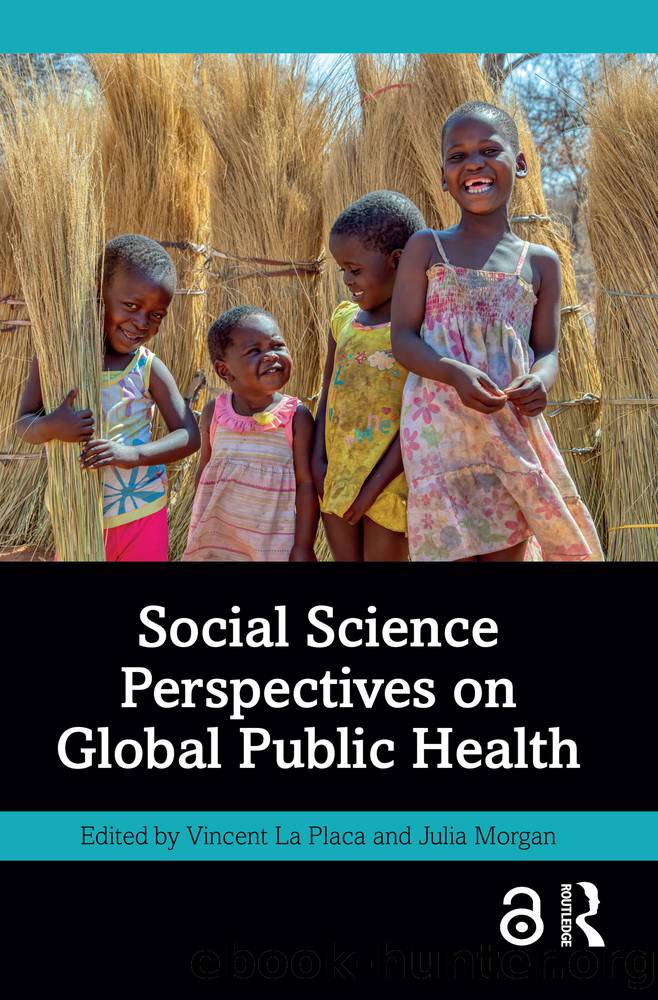Social Science Perspectives on Global Public Health by Vincent La Placa & Julia Morgan

Author:Vincent La Placa & Julia Morgan [Morgan, Julia]
Language: eng
Format: epub
Publisher: Taylor and Francis
Published: 2022-08-11T00:00:00+00:00
Femicide and Male Violence against Women and Girls
Male violence against women and girls is a significant global issue and implicates both structural and cultural violence. For example, the World Health Organization (2021b) estimates that around 736 million women, or one in three, have been exposed to IPV or sexual violence from a non-partner. Another issue is femicide or feminicides, the misogynous killing of women and girls by men, which is often legitimised by patriarchal social, and cultural institutions. This can include both intimate-related and non-intimate-related murder: honour and dowry-related killings, homophobic, and transphobic murders; and gender-based pre-natal abortions, as well as infanticide of girls (Radford and Russell, 1992). Across the globe, femicide is increasing at the same time as the general murder rate is decreasing (United Nations, 2019) and in 2017, 87,000 women were murdered, with 58% killed by family members (24%) or intimate partners (34%) (UNODC, 2019).
Women are, therefore, more likely than men, to be killed by people they know, with much of this violence being perpetrated in the home. Looking at specific countries, we can detect high rates of femicides in Honduras (6.2 femicides per 100,000 women) (Economic Commission for Latin American and the Caribbean, 2021); whilst in the UK, during the period 2009 to 2018, at least 1,425 women were killed by men, meaning that a woman died every three days (Long et al., 2020). In relation to regions of the world and intimate partner femicide, the African region has the highest rate, with 3.1 deaths per 100,000 women (UNODC, 2019), whilst concern has also been raised about the racist femicide of Indigenous women; with Indigenous women in Canada being approximately six times more likely to be murdered than non-Indigenous women (Canadian Femicide Observatory for Justice and Accountability, 2021).
Structural and cultural violence are implicated in male direct violence towards women and girls. Feminist critical theory shows us that patriarchal societies can be perceived to represent women as âotherâ to men (De Beauvoir, 1949), and the âothernessâ ascribed to women is often characterised by one of dehumanisation, as well as dominance, with women subordinated to male power, and the structures which support male power. The subordination of women to men constitutes structural violence, creating inequalities, a lack of access to resources, including land and money, gender pay gaps, the devaluing of womenâs contributions, limits on freedom in public spaces, a lack of representation in politics, as well as criminal justice systems, which are discriminatory. Cultural or symbolic violence is also implicated within representations of violence against women in the media and in film, as well as hegemonic ideological justifications, which devalue women, and support the position which is ascribed to them. Direct violence by men, towards women and girls, therefore, reflects both structural and symbolic/cultural violence and is an exertion of power over the subordinated or devalued (Bourdieu, 2001). It is also important to understand how intersectional identities, such as gender and ethnicity, can make it more likely that women and girls are subjected to violence by men.
Download
This site does not store any files on its server. We only index and link to content provided by other sites. Please contact the content providers to delete copyright contents if any and email us, we'll remove relevant links or contents immediately.
Social Science Perspectives on Global Public Health by Vincent La Placa & Julia Morgan(267)
Rosenâs Emergency Medicine Concepts and Clinical Practice by Ron Walls; Robert Hockberger; Marianne Gausche-Hill; Timothy B. Erickson; Susan R. Wilcox(233)
Oxidative damage to surfactant protein D in pulmonary diseases by Vitality Starosta1 & Matthias Griese1†(231)
Organic Chemistry: An Acid - Base Approach by MICHAEL SMITH(214)
Human Microanatomy; Cell Tissue and Organ Histology with Celebrity Medical Histories by Stephen A. Stricker(165)
Socio-Life Science and the COVID-19 Outbreak : Public Health and Public Policy by Makoto Yano; Fumihiko Matsuda; Anavaj Sakuntabhai; Shigeru Hirota(149)
Saunders Nursing Drug Handbook 2024 - E-Book by Unknown(148)
Davis's Comprehensive Manual of Laboratory and Diagnostic Tests with Nursing Implications by Unknown(147)
Berne and Levy Physiology E-Book by Unknown(136)
Replacing the Dead by Mie Nakachi;(127)
The Pocket Guide to Sensorimotor Psychotherapy in Context (Norton Series on Interpersonal Neurobiology) by Pat Ogden(126)
Lessons From the Damned: Queers, Whores, and Junkies Respond to AIDS by Nancy E. Stoller(122)
Handbook of Skin Disease Management by Jiyad Zainab;Flohr Carsten; & Carsten Flohr(121)
Themes and Stories in Youthwork Practice by Mark Krueger(121)
Deep Learning and Medical Applications by Unknown(117)
Mosby's 2024 Nursing Drug Reference (Skidmore Nursing Drug Reference) (by Team-IRA) by Linda Skidmore-Roth RN MSN NP(116)
CliffsNotes EMT-Basic Exam Cram Plan by Northeast Editing Inc(113)
Antioxidants by Gerald Litwack(109)
Plants for Immunity and Conservation Strategies by Manoj Kumar Mishra & Nishi Kumari(109)
